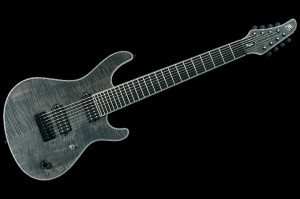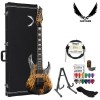Is a Seven String Guitar or an Eight String Guitar Right for Me?
Should I get a Seven String Guitar or an Eight String Guitar?
So, you’re thinking of taking the plunge and experimenting with a non-6 string guitar – maybe a seven string guitar, or perhaps even an eight string guitar? Well, here’s a list of the top 5 reasons why you should look into doing just that!
1. You want new chord possibilities
The additional 7th or 8th string allows you to have more range when it comes to playing chords because the additional string or strings can be added to either side of the guitar, thus creating different chord options. Not only will this provide you with an opportunity to develop your understanding of chords, but you can also become a vital part of a band with your ability as a rhythm guitarist to create unique sounds with these chords.
2. You want new scale possibilities
The additional strings allow you to extend the range of your scales and you can experiment with new licks that cannot be played on the 6 string. This ability allows lead guitarists to utilize the additional low string(s) or high string(s) to add a new dimension to their solos.
3. You want new tuning possibilities
You get to experiment with different 7 string and 8 string guitar tunings and different sounds that cannot be created with a traditional 6 string guitar. In the words of George Van Eps when discussing the seven string guitar, “There are basically three tunings to think about with the 7-string: strings 6 through 1 are in standard tuning (E, A, D, G, B, E, low to high) and strings 7 through 2 are in the secondary tuning (A, E, A, D, G, B). You’ll find that things which lay in terrible positions and require long reaches on a 6-string will lay right under your fingers in the secondary tuning, which frees up your left-hand fingers to provide moving voices. The third tuning is all seven strings integrated (A, E, A, D, G, B, E). If you have any ears at all, and are willing to get calluses on your fingers and your behind, you’ll learn how to put them all together.” Similarly, eight string guitars provide even more tuning possibilities due to having 2 additional strings.
4. You want to accompany your own playing
You can utilize the extra bass strings to play melody and bass lines at the same time. This type of playing is probably best suited for jazz-style music, but it is a great plus nonetheless! To see an example of this type of playing on an eight string guitar, take a look at the Charlie Hunter video on this page.
5. You want to stand out from the crowd
Plain and simple – you want to be unique, stand out from the crowd, and challenge yourself to become a better guitar player. Everyone’s heard of the 6 string guitar, but how many people have actually heard of or played a seven string guitar or an eight string guitar? You can definitely make a name for yourself by becoming a proficient player on one of these unique and exciting instruments!






